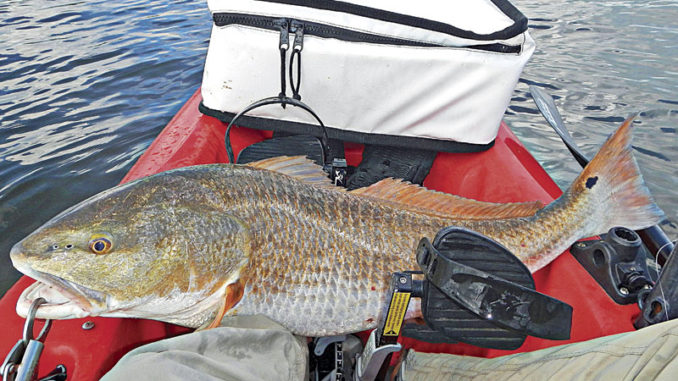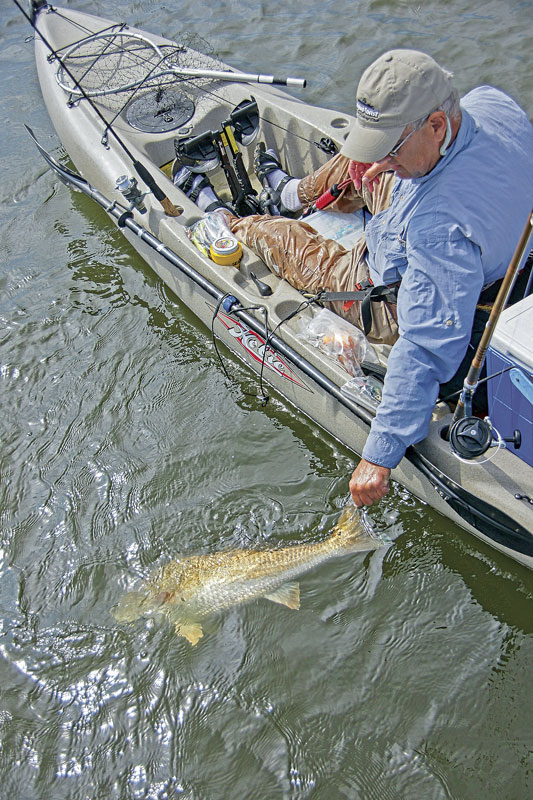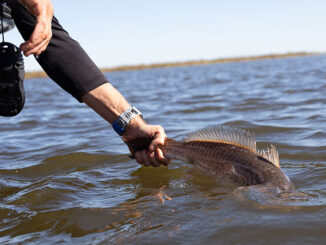
Choose your trips with caution, then put the hammer down on reds
Fishing during the summer is obviously more popular in Louisiana than fishing during the winter. However, as the Sportsman’s Paradise, we have so many hook-and-barrel pursuits that it’s tough to do it all. Fishing, as opposed to hunting, has no closed seasons, so sportsmen who enjoys both tend to slack off a bit on fishing during the winter to take advantage of hunting seasons.
For those kayak anglers who don’t hunt — or those that get a weekend or two free from hunting — redfish fishing this time of year can be fantastic. They are cold-water tolerant and predictable. Kayakers who carefully pick their locations and techniques can find some very hot cold-water action.
Winter in Louisiana is a relative term. One day may demand full, winter gear, while others may allow for wearing shorts and sandals. The key to successfully pursuing redfish is a consistent weather pattern. General winter conditions bring to the coastal marshes extremely low tidal conditions and cold fronts with nearly unbearable winds.
Of course, kayak anglers are particularly susceptible to the elements and should avoid unsafe conditions. Proper wind and waterproof gear is essential. As conditions calm, they can actually be a boon to the tactful kayak angler.

Low-water advantages
The low tides of winter allow kayak anglers to actually see the bottom conditions and structure in given areas. Oyster bars are readily visible and point the angler to areas where redfish congregate in winter. The inside turns of a bayou will show mud flats; however, the outside banks of any sharp turns are scoured deeper than the surrounding areas and are a good bet for finding concentrated redfish.
Fishing an oyster-covered bottom that runs deep into a canal or an outside bayou turn generally leads to redfish stacked up — literally on top of each other. They gather where the deep water provides warmer, more stable temperatures. It is not uncommon for a group of kayak anglers to catch and release scores of reds without ever moving from a spot.
Winds concentrate bait against the shoreline, and reds are there to wreak havoc. Utilize this to your advantage and either stake out within casting distance or drift down the shoreline as conditions allow. Finding such areas that receive the wind generally means a redfish bonanza that can quickly provide plenty of action.
Weather stability is the key. Immediately after a front can be slow. However, a few days after the passage, when the weather stabilizes, reds are generally stacked in deeper areas. If it warms a bit, reds move in and spread out along nearby shallower bays and shorelines. The bright, winter sun quickly radiates through the shallower waters to the dark muddy or shell-covered bottoms. This causes the water in these areas to warm by several degrees. Even this slight warming of the water temperature can turn winter redfish into feeding machines. They are a bit more spread out, but can still be caught. They remain in these ares in order to have easy access to move back to deeper, warmer waters when conditions again turn cold.
Not picky eaters
Reds are bottom feeders and root around searching for any critters they can find. The have powerful crusher in their mouths that are great for dispatching their favorite prey of shrimp and crabs. However, redfish also eat small fish and readily take artificial baits. Any artificial bait that reasonably resembles food to a redfish is quickly devoured if cast in their vicinity. They are not picky.
Known for their quick, drag-burning runs, these bronze brutes can easily test an angler’s stamina. There is nothing more exciting than a big red screaming across a clear, shallow pond. Their power is evident as soon as you set the hook and they put up a great fight in the kayak. Be ready for strong, charging runs, sometimes pulling the kayak with them as they try to regain their freedom.
During the winter, dead shrimp and live minnows are the preferred baits of many kayak anglers. Slowly fished, Carolina-rigged on the bottom or dangling under a popping cork, these natural offerings easily entice a hungry redfish.
However, for those that prefer the trickery of artificial baits, redfish are quick to oblige. Soft plastic minnow imitations, small crankbaits, and spinnerbaits, all put redfish on the end of your line. A major redfish favorite is the weedless gold spoon. They can’t resist the wobble and flash of these glittery chunks of metal. Spoons are simple to use and their streamline shape and weight make them ideal for kayak casting in winter winds.
Concentrated by the cold
Contrary to some belief, redfish don’t just show up in the marsh in winter. They live there for the first several years of their lives until they move offshore into the Gulf of Mexico for spawning. However, winter conditions can greatly concentrate them.
When the weather is cold, battling one redfish after another from a kayak quickly warms things up. While challenging, redfish are relatively easy to catch and offer terrific sport for kayak anglers. Instead of sitting by the fire dreaming of those warm spring days to come, put on some warm, waterproof gear and head to the marsh for some of the hottest kayak fishing around.
Hypothermia kills
Kayakers are particularly susceptible to hypothermia. Kayaks offer no protection from the elements, and you are going to get wet. For safe fishing in cold-weather conditions, wearing a PFD and warm, wind and waterproof clothing from head to toe is a must.
Your body heat drops quickly if you are wet or exposed to cold wind. Tight clothing hinders circulation and can contribute to hypothermia.
Here are some tips for preventing and dealing with hypothermia.
- Dress appropriately and stay warm and dry.
- Conserve energy. Exhaustion leads to a quicker onset of hypothermia.
- Symptoms of hypothermia are confused speech, sleepiness and disorientation.
- Shivering is your body’s attempt to generate heat and ward off hypothermia.
- Alcohol, caffeine and tobacco exacerbate hypothermia and should never be used if you will be exposed to winter elements.
- Treat the symptoms of hypothermia with dry clothing, a warm fire, warm liquids (no coffee, tea or alcohol) and high-energy foods.


